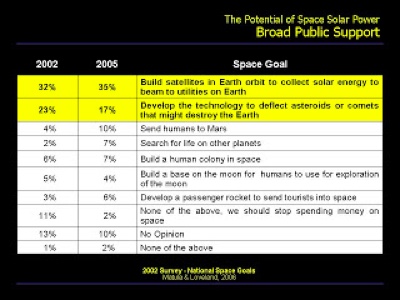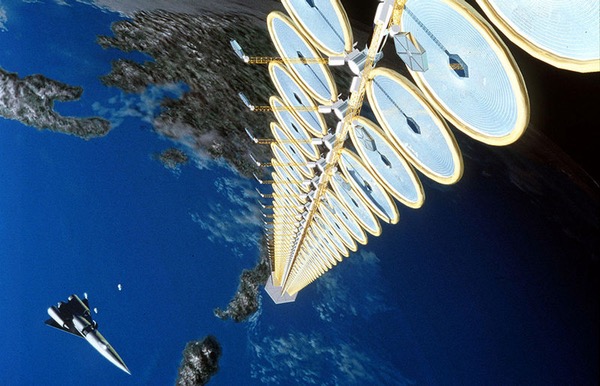Better than Paris: space solar powerby Lt. Col. Peter Garretson
|
| I’m with Elon Musk that we need to figure out how to stop experimenting with dumping carbon in to out atmosphere and find a better way. But I’m pro-business and pro-growth, not anti-growth, and believe that business and technological innovation are more powerful tools than restraint. |
Now if that’s technically feasible—and a lot of credible institutions have said that it is, including NASA, the Department of Energy, the Department of Defense, the International Academy of Astronautics, and the National Academies—then why isn’t this on the agenda? Maybe because our national space program has been run by public servants who think about flags and footprints to show off national plumage, and not businesspeople looking for new markets and competitive advantage.
Look, I’m a “Pentagon Green”—strong on defense, and a fiscal conservative who believes that climate change and energy security represents real national security threats. I’m with Elon Musk that we need to figure out how to stop experimenting with dumping carbon in to out atmosphere and find a better way. I believe in the power of innovation. But I’m pro-business and pro-growth, not anti-growth, and believe that business and technological innovation are more powerful tools than restraint.
Few have articulated the really big picture better than Amazon and Blue Origin founder Jeff Bezos:
We need to go into space if we want to continue to have a growing civilization. If you take baseline energy usage on Earth and compound it at just 3 percent a year for 500 years you have to cover the entire surface of the Earth with solar cells. That's just not going to happen. If we want to continue to grow—another route would be to just face stasis and not continue to grow—I don't think that's as interesting, I don't think you want to survive on this planet, I think you want to–you know—thrive and do amazing things. And to do that we need to go out into the solar system… I predict that in the next few hundred years, all heavy industry will move off the planet. It will just be way more convenient to do it in space, where you have better access to resources, better access to 24-hour solar power. You know, solar power on Earth is not that great because the planet shades us half the time. In space you get power all the time. So there will be a lot of advantages to doing heavy manufacturing there, and Earth will end up zoned residential and light industry. You know, we want to go to space to save the Earth.
Amen. Jeff’s sentiments are right on. And, by the way, widely shared in the American public.
Surveys by Matula and Loveland have shown that when offered the choice, Americans overwhelmingly choose “Build satellites in Earth orbit to collect solar energy to beam to utilities on Earth” above other space goals. A pity they have never been given such a choice.
 Survey results show public interest in SBSP. |
The Pentagon tried to give America that choice in 2008, publishing a report “Space Based Solar Power: An Opportunity for Strategic Security” aimed to get the attention of President George W. Bush to get us off our addition to foreign oil, but without any luck. We thought the incoming Obama Administration would take action on it given its capability to solve climate change, but despite pushing it as one of the administration’s first white papers, and an “all of the above” energy strategy, the administration was literally not looking “above.” The Obama Administration started its Open Government Internet initiative. Space Solar Power became the number one idea at OpenNASA, OpenEnergy, and OpenOSTP, but no action was taken.
| In my judgement, America could easily get the launch costs required to make space solar power possible, and at least three American companies have viable paths to reduce the mass of satellites to make them profitable even without further launch cost reductions. |
The State Department tried in 2010 to make it a deliverable for international cooperation for Obama’s first trip to India, but it was stillborn. India’s former president, Dr. APJ Kalam, and the US-based National Space Society tried to put it on the agenda with a public initiative aimed at the administration, but was ignored. The Pentagon tried again in 2016, holding competitions across the federal government for the best ideas that could advance comprehensive national power. The Space Solar Power D3 Proposal took first honors, and even presented their vision video at the White House, but no action was taken. Even with eight years of a president with an agenda for renewable energy, innovation, and action on climate change, the one idea that could have been truly revolutionary was ignored, and an opportunity for a real legacy was lost.
In that interim, of course, first Japan, and then China, started national programs. While we had our head in daydreams of the Martian sand, China’s scientists elaborated their plan to “carry out the most ambitious space project in history. Once completed, the solar station, with a capacity of 100MW, would span at least one square kilometre, dwarfing the International Space Station and becoming the biggest man-made object in space.” Its generals articulated China’s plans to “exploit Earth-Moon space for industrial development. The goal would be the construction of space-based solar power satellites that would beam energy back to Earth,” in the words of Lt. Gen. Zhang Yulin, Strategic Support Force. China boldly publishes vision videos of their designs for a global audience.
Mike Snead, a visionary formerly at Air Force Research Lab noted that the Paris accords instantiated what were anticipated to be an annual transfer of $100 billion to nations considered “victims of climate change.” (See “A Trump Administration path to advance commercial space solar power”, The Space Review, December 12, 2016.) That $100 billion could be spent to much greater effect on space solar power. Past estimates have suggested that the total non-recurring capital to develop economic solar power satellites, build factories, and launch fleets to turn them out, one after another, would only be about $100 billion (spent over 10 years), with industry paying 90 percent of that, after less than $10 billion of taxpayer investment to help prove initial designs. That’s one-tenth the cost of the International Space Station, and less than America is spending on its Apollo-on-Steroids Space Launch System (SLS). It’s not even a percent of what we spent on our overseas adventures in Iraq and Afghanistan, not even a percent of what we are considering on national infrastructure.
I used to be the Chief of Air Force Future Technology for Headquarters Air Force. Now I train the next cadre of Air Force Officers in long-term strategy for comprehensive national power in space. In my judgement, America could easily get the launch costs required to make space solar power possible, and at least three American companies have viable paths to reduce the mass of satellites to make them profitable even without further launch cost reductions.
But private industry can only do so much. Major new markets require action on the part of the government to advance pre-competitive technology, establish clear policies, lower barriers to entry, and establish a business- and innovation-friendly environment of authorization, regulation, and liability. Government can accelerate US advantage and cultivate national strategic industries by using becoming anchor customers and making advanced purchases.
At least until the actual stand-up of the National Space Council, the true center of gravity for comprehensive space power—and the only meaningful source of US government space leadership—is now Congress. Not NASA: they are tone deaf to anything that is not planting new flags and footprints or compelling new science. Not the Air Force, as they are entirely focused on warfighting, missing out entirely on the larger conversation about space industrialization. No, it only a few visionary leaders in Congress who are engaged and understand the vast opportunities for wealth and power afforded by the energy and material wealth of the inner solar system.
| One need not be motivated to limit carbon to begin a US space solar program: there are sufficient other motives. Whether these men believe in climate change hardly matters if they do something effective about it. |
It was not the President, but Congress that established the Commercial Space Launch Competitiveness Act that affirmed private industry’s ability to mine asteroids. NASA and the Air Force are not leading the conversation. It has been Congressman Rohrabacher (R-CA) who for decades have supported Space Solar Power and asteroid defense. It is Congressman Mike Rogers (R-AL) who is pushing our nation to go after comprehensive space power, to organize for victory. It is Congressman Bridenstine (R-OK) who sought empowering legislation in a Space Renaissance Act. It is Senator Cruz (R-TX) currently holding hearings on re-opening the American frontier.
One need not be motivated to limit carbon to begin a US space solar program: there are sufficient other motives. Whether these men believe in climate change hardly matters if they do something effective about it. Certainly those ideologically committed to the problem had their opportunity and failed. It might be ironic if men who are unconcerned with carbon emissions might do the most to solve it, but climate is not the only issue at stake—so is US primacy in space and the possibility of another American century.
If America is not to lose this space race—the only one that matters—to exploit the energy and material wealth to make our planet a cleaner, greener place, it will fall to the few Congressmen with the vision and engagement to place us on that course.
